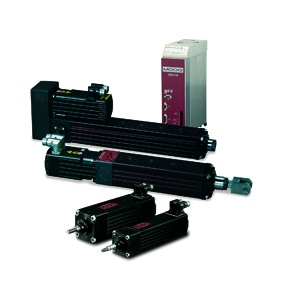Roadway Barriers Go Electric
June 2, 2011

Roadway barriers, the last line of defense for hundreds ofmilitary installations and utility plants, are undergoing a transformation.Once powered exclusively by hydraulics, the giant barriers are now moving tosimpler, greener electric actuators.
Roadway Barriers Go Electric_A |
For roadway barriers, that's a big change. Designed to stop a15,000-lb truck traveling at 50 mph, the beefy barriers have traditionallyemployed hydraulics as a means of quickly raising 6,000 lb of steel into thepath of a truck.
"The idea was always to be able to stop the biggest, baddesttruck you could find," says Paul Roland, director of engineering at the American Physical Security Group (AmericanPSG), a maker of roadway barriers. "They have to stop the truck with zeropenetration and still be operable
afterward."
Doing so with a servo motor and a ball screw, however, is acomparatively new idea. For more than a quarter-century, makers of the steelbarriers have employed hydraulic actuators, largely because they offered -- and still offer - tremendous power density.
But barrier makers are teaming with electric actuatormanufacturers to change that.
"The servo is the only electric motor that can give you the powerdensity you need for this application," says, Don Bockhahn, product applicationmanager for electromechanical actuators for MoogIndustrial Controls, a maker of motion control products (including bothelectric and hydraulic products). "Thepower density is very similar to that of a hydraulic system, and that allows usto quickly raise the plates."
Protecting High-Value Targets
Indeed, the roadway barrier plates needto be raised fast. The barriers, which came into being after the Beirut truckbombing that took the lives of 241 American servicemen in 1983, are called uponto lift giant metal plates into position in less than two seconds. The concept,originally proposed by the U.S. State Dept. more than a quarter-century ago, isintended as a means of stopping bombings like those in Beirut in '83 and inOklahoma City in 1995. The plates, which can measure up to 16 ft wide and weighmore than 6,000 lb, operate in a manner similar to that of a pre-hung door withan underground hinge. The actuators swing the "door's" free end upward,enabling it to stop a mammoth truck dead in its tracks. The U.S. military,along with utilities and private companies, use a surprising number of thebarriers. They're said to be employed at numerous government buildings aroundWashington D.C., at nuclear power plants, in hundreds of military installationsaround the world, and even at banks and courthouses around the U.S.
"They're used to protect any high-value target that a terroristcould go after," Bockhahn says.
The barriers typically lie in a pit underneath a roadway. When acar or truck approaches, a guard can deploy the device's steel plate by hittingan EFO (emergency fast operation) button. When the button is pushed, the systemsends a signal to a servo controller. The servo controller, in turn, operates aservo motor that turns a ball screw, which moves a rod in and out of theactuator.
Roadway Barriers Go Electric_D |
American PSG employs a Moog Electric Linear
Servo Actuator on itsSW12 wedge barrier. During operation, the actuator is controlled by a MoogServo Drive, which operates off standard three-phase, 230V or 460V ac current.The drive rectifies the ac current to a dc voltage, filters it, and modulatesthe pulsewidth to get the desired velocity. An encoder on the back end of theactuator "knows" the position and speed of the servo motor at all times. Inessence, the servo drive closes the loop on the actuator by controlling currentinto the motor. As a result, it controls the torque of the motor and the forceout of the actuator.
"When the servo system gets a command to move, it accelerates ata pre-programmed acceleration rate, then decelerates to a target position,"Bockhahn says. "So we can make it accelerate smoothly up to pre-programmedspeed, and then decelerate it to a position."
At high speeds, the actuator can travel a full 12-inch strokelength in about one second. It has a continuous force rating of about 6,200 lband a peak capability of more than 16,000 lb.
Engineers say that the choice of a dc servo motor is critical tomoving the barrier plate into position. "If you use an ac motor, it's not goingto be able to move a barrier that big at that kind of speed," Bockhahn says.
Simplicity Is Key
Until the last three or four years,hydraulics have dominated such applications, largely because of the need forpower density. Today, hydraulics are still sold into roadway barrier systems,but electric actuators are growing in popularity.
"It's partly due to people wanting to go green," says Roland ofAmerican PSG. "They feel there's a positive environmental impact to be gainedby using electrics, as opposed to hydraulics."
In truth, the environmental differences aren't as great as theymight seem. New vegetable-based oils don't pose the same environmental worriesas conventional hydraulic oils once did. With the vegetable-based products,maintenance workers can reportedly spill gallons of oil without concern.
"The real environmental threat of hydraulics is probably not asgreat as people imagine," Roland says.
Still, engineers say there are other advantages to be gained byusing electric actuators on roadway barriers. The simplicity of a dc actuator,for example, makes it easy for users to speed up the movement of the barrier,merely by boosting the voltage.
Moreover, Roland says that some users prefer the simplicity ofmaintenance that electric actuators offer. Unlike, hydraulic systems, whichincorporate pumps, cylinders, valves, accumulators and hoses, electric unitshave few parts and can be easily repaired and replaced. "Electric is muchsimpler," Roland says. "It's not nearly as intimidating to people ashydraulics."
To be sure, representatives at Moog aren't proposing a universalmove to electrics over hydraulics, especially since they manufacture both typesof systems. But they do point to the higher force that's now available fromelectric actuators, and they acknowledge that, as a result, the electrics arestarting to move into applications such as the roadway barriers, which oncewere the exclusive province of hydraulics.
Click hereto watch a video of the roadway barriers stopping a truck.
About the Author(s)
You May Also Like






.jpg?width=300&auto=webp&quality=80&disable=upscale)


